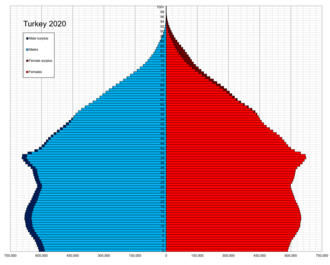
Back التركيبة السكانية في تركيا Arabic Türkiyə əhalisi Azerbaijani تورکیه دموقرافیسی AZB Население на Турция Bulgarian তুরস্কের জনমিতি Bengali/Bangla Demografie der Türkei German Demografiya Tırkiya DIQ Demografía de Turquía Spanish جمعیتشناسی ترکیه Persian Démographie de la Turquie French
| Demographics of the Republic of Turkey | |
|---|---|
 Turkey population pyramid in 2020 | |
| Population | (31 December 2023) |
| Growth rate | |
| Birth rate | population (2023) |
| Death rate | population (2022) |
| Life expectancy | |
| • male | |
| • female | |
| Fertility rate | |
| Infant mortality rate | |
| Age structure | |
| 0–14 years | |
| 15–64 years | |
| 65 and over | |
| Sex ratio | |
| Total | 0.99 male(s)/female (2021)[2] |
| At birth | 1.05 male(s)/female (2022) |
| Under 15 | 1.05 male(s)/female (2022) |
| 65 and over | 0.82 male(s)/female (2022) |
| Nationality | |
| Nationality | noun: Turk(s) adjective: Turkish |
| Major ethnic | Turks |
| Language | |
| Official | Turkish |
| Spoken | See Languages of Turkey |
Demographic features of the population of Turkey include population density, ethnicity, education level, health of the populace, economic status, religious affiliations and other aspects of the population.
As of 31 December 2023,[update] the population of Turkey was 85.3 million with a growth rate of 0.11% per annum.[3] Turks are the largest ethnic group.
By ethnicity Turks (70-75%), Kurds (19%), other (6-11% including Arabs, Albanians, Bosniaks, Circassians, Chechens, Georgians, Romani, Laz people and others) (2016 estimate)
The population has been aging in recent years, with just 21.4% falling in the 0–14 age bracket (down from 26.4% in 2007).[4] The population over the age of 65 is 10.2% (up from 7.1% in 2007). As of 2023,[update] the median age of the Turkish population is 34 years (up from 28.3 in 2007).[5] According to OECD/World Bank population statistics, from 1990 to 2008 the population growth in Turkey was 16 million or 29%.[6]
- ^ "TURKSTAT Corporate". data.tuik.gov.tr. Retrieved 15 May 2023.
- ^ "TurkStat".
- ^ "TURKSTAT Corporate". data.tuik.gov.tr. Retrieved 6 February 2024.
- ^ "TÜİK Kurumsal".
- ^ "TÜİK Kurumsal".
- ^ CO2 Emissions from Fuel Combustion Archived 12 October 2009 at the Wayback Machine Population 1971–2008 (pdf Archived 2012-01-06 at the Wayback Machine pages 83–85) IEA (OECD/ World Bank) original population ref e.g. in IEA Key World Energy Statistics 2010, p. 57.
© MMXXIII Rich X Search. We shall prevail. All rights reserved. Rich X Search